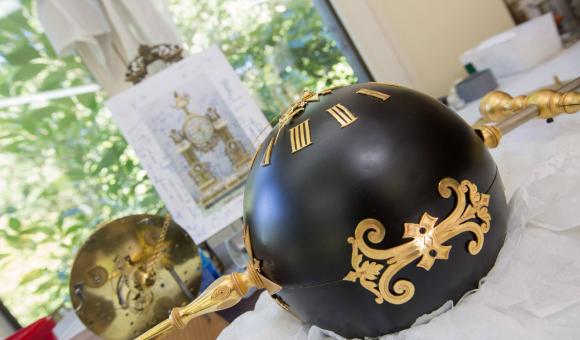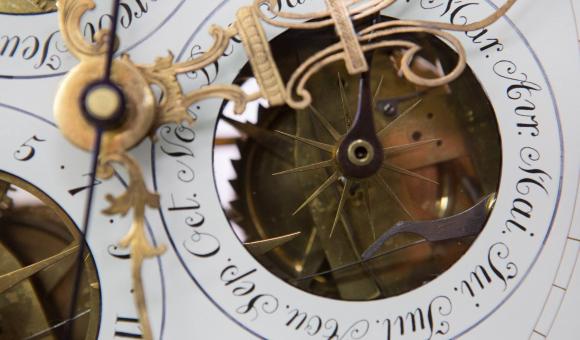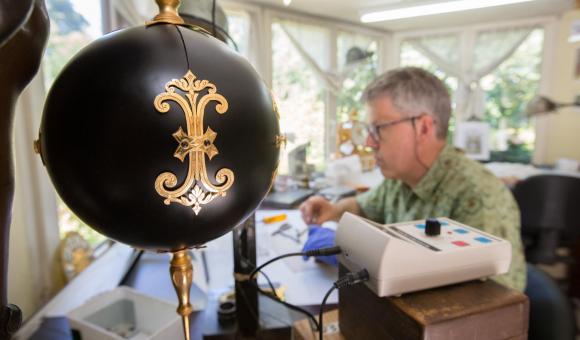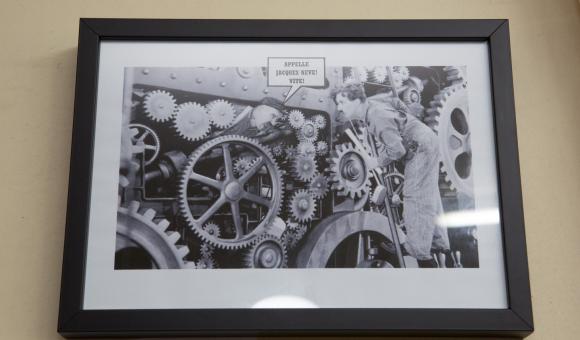To enter the world of Jacques Nève is not only to make a leap into the past but also to discover incredibly modern objects. This is because the genius of the 18th and 19th century clockmakers is more than a match for even the most modern productions. Wearing his three hats, Jacques Nève defines himself as an artistic clockmaker: he is a restorer, antique dealer and expert in antique clocks. Entering his workshop and his world is, to say the least, a privilege, that of discovering totally unique and even unexpected items. It was in Australia that Jacques Nève, artistic clockmaker laid the foundations for what would become his job and great speciality. Passionate about mechanics and old objects, the combination of these two worlds is found in artistic clockmaking, which he has loved for 25 years.
Mystery Clock: Robert-Houdin
Restoration: Jacques Nève, all rights reserved
LMdO: In the workshop, I spotted your collection of 1:8 scale replica Citroën DS. You seem to like beautiful mechanisms?
Jacques Nève: I'm a fan of the DS and English cars, made for drivers. It's another approach to mechanics, as the world of watches from which I have since moved away, must have been. The clock is a bit like a combination of all these worlds, it is the one in which I flourish best, the one that best suits me. Modern mechanics is a bit too easy for my tastes, I prefer to tackle older systems or pieces that may have to be entirely rebuilt by hand. The challenge is greater and I encounter an incredible wealth in the variety of the pieces. Artistic clocks are rare and were sometimes produced in very few examples. It's a privilege to discover them.
LMdO: How do you start to track down such rare two-hundred-year-old objects?
JN: The microcosm of artistic clockmaking being what it is, we have our sources and our sources know us. The handful of European specialists of which I am part has its preferred fields but of course competition is tough. Paradoxically, the internet is the best and worst of things. The best because it allows us to handle many leads without leaving home but the worst because I am obviously sure I'm not the only one using it. The time when you could boast about being the only person to locate a rare piece and wanting to acquire it is long gone. For me, it's become complicated because if a piece has been offered to colleagues to promote competition, I lose interest almost immediately.
LMdO: Do you have favourites?
JN: I have to stay rational. Above all this is a business, but my philosophy is always changing. Some pieces that I bought 10 years ago no longer interest me. Ophelia for example (editor's note: the name given to the mystery clock being restored during my visit) is one of the most beautiful things an artistic clockmaker could dream of. I was in a sale room in London and it was my daughter who happened upon this incredible mystery clock down a path. I examined the piece in detail, struck by the genius of the clock mechanism set in this totally unique piece. I only knew of one other statue of this size and as beautiful, which was fitted with a clock. It is unlike this piece incidentally and must be in the United Kingdom. This truly wonderful discovery was only possible because the price was reasonable and because my expertise in restoration was going to make all the difference. I've been working on it for several weeks and someone is really going to have to dig deep if they want me to part with it. These are pieces that you only see once in a lifetime.
LMdO: Don't all these beautiful mechanisms make you want to step through the looking glass and create your own movement?
JN: You might think so as it becomes complicated for me to find clocks that still manage to surprise me. Mystery clocks are genuine testimonies to human ingenuity, in the person of Eugène Robert-Houdin for example. But no, my passion is really restoration, I leave the creation to those who choose it. The craziest mechanisms are still possible today. Buchanan's in Australia is a good example. This is a small engineering firm that designed and is in the process of creating an astronomic clock mechanism of incredible complexity taking tens of years of effort and work. In some way, this is the distinctive feature of our profession; only the very high-end mechanisms are of interest to the specialists.
Jacques Nève talks to us about the J Pratt that he has affectionately renamed "Ophelia" during the clock's time in the restoration workshop.
"Large-scale mystery clock with torsion pendulum, signed J. Pratt Comptoir General, Paris. Circa 1890. Large Paris-type movement with Brocot half-rollers escapement of exceptional size interacting with a 9-teeth escape wheel(!). The swing is through a rod inside the larger vertical rod suspended by the arm of the statue. The sphere swings from left to right at about a 30° angle, hanging through two long and thin suspension blades. Countwheel strike every half-hour on a silvered bell. Autonomy 8 days. The aforementioned sphere is hollow and made of black-painted brass, it contains the clock's movement. The dial has twelve applied chased gilt-brass Roman hour numerals surrounding a central star and two finely chased gilt-brass half-moon hands. The two-tone patinated spelter support, in the form of a draped female figure inspired from celebrated Italian Renaissance models; the sculpture in contrapposto, brings movement and lightness to the composition. She gracefully supports the long shaft with its decorations and accessories which terminates in a sphere indicating the time and a fine point below it. The latter highlights the impression of mystery emanating from the sphere, which moves around itself instead of swinging to-and-fro. The young girl's hand remains stationary and, yet, the sphere continues to move with no obvious impulse to keep it going! Genuine masterpieces and triumphs of ingenuity, mystery clocks are designed to hide their workings, creating the kind of illusion we see here: a contrast between the figure’s perceived movement and the sphere’s static horological precision."
Full article and illustrations on www.lesmiroirsdelombre.com





